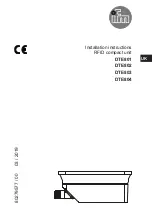
IP Relay HWg-ER02b - Manual
HW group
www.HW-group.com
26/ 42
&S: Stop bits
2
Number of stop bits for the serial communication. As a rule, there should be at least 9 bits and at
most 10 bits in total, excluding the start bit. For instance, the 7N1 setting (7+0+1 bits) is corrected by
the setup to 7N2. Similarly, 8E2 (8+1+2 bits) is corrected to 8E1.
&C: Flow Control
NONE
Serial data flow control. If you use data flow control and the input buffer is full, handshake will signal over
the serial port that the IP Relay can no longer accept data.
1: none
– No control, see &R for RTS
2: RTS/CTS
– RTS/CTS control signals
3: Xon/Xoff
– Software flow control
4: Xon/Xoff HeartBeat
– SW flow control with periodic Xon transmission (heartbeat)
&R: RTS Output Continuously asserted [~ +8V]
Defines the idle level of the RTS output pin. Important for devices powered from the RTS pin.
0: RTS = continuously asserted [~ +8V]
1: RTS = unasserted [~ -8V]
2: RTS = asserted while connected
&A: DTR Output
Defines the idle level of the DTR output pin. Important for devices powered from the DTR pin.
0: DTR = continuously asserted [~ +8V]
1: DTR = unasserted [~ -8V]
2: DTR = asserted while connected
&I: RS485/RS422 control Off
For RTS or downstream RS485 converters that use RTS to toggle transmission/reception. For the built-in
RS-
485 driver, the “
HW echo
” option applies, meaning that the device reads back the data sent to the RS-
485 line and generates an echo from the actual RS-485 bus.
0: Off
2: TxRTS HW echo ON
(recommended for
RS-485 debug only!
)
3: TxRTS HW echo OFF
(
RS-485
)
Note:
For most RS-485 applications, set &R3TxRTS HW echo OFF
.
&T: Serial Line Timeout
0
– Off
If no data are received from the serial line for the specified time, characters received so far are
packed into an Ethernet packet and sent off.
The timeout is specified as the
number of characters
, and displayed as the number of chars as well
as the time based on the current serial communication speed. If the speed changes, the time is
recalculated but the number of characters defining the timeout stays the same (10 characters means
about 11 ms at 9600 Bd, or 5.7 ms at 19200 Bd).















































